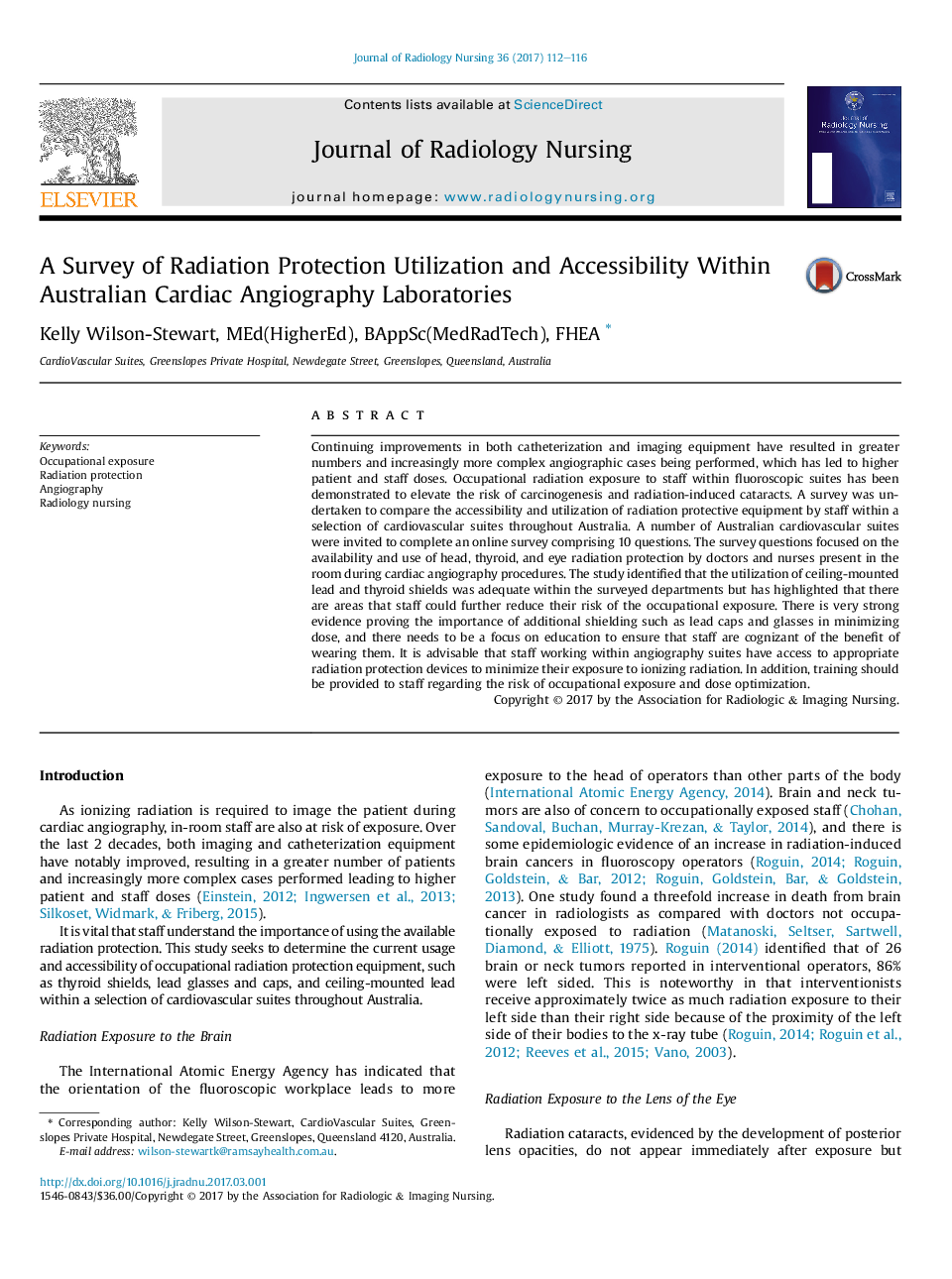| کد مقاله | کد نشریه | سال انتشار | مقاله انگلیسی | نسخه تمام متن |
|---|---|---|---|---|
| 5570666 | 1403764 | 2017 | 6 صفحه PDF | دانلود رایگان |
عنوان انگلیسی مقاله ISI
A Survey of Radiation Protection Utilization and Accessibility Within Australian Cardiac Angiography Laboratories
ترجمه فارسی عنوان
بررسی استفاده و دسترسی به حفاظت از اشعه در آزمایشگاههای آنژیوگرافی قلب استرالیا
دانلود مقاله + سفارش ترجمه
دانلود مقاله ISI انگلیسی
رایگان برای ایرانیان
کلمات کلیدی
قرار گرفتن در معرض شغلی، حفاظت در برابر اشعه، آنژیوگرافی، پرستاری رادیولوژی،
ترجمه چکیده
بهبود مستمر در هر دو کاتتریزاسیون و تجهیزات تصویربرداری منجر به افزایش تعداد و موارد پیچیده آنژیوگرافی پیچیده شده است که منجر به افزایش دوزهای بیمار و کارکنان شده است. قرار گرفتن در معرض تابش شغلی کارکنان در سوئیت های فلورسکوپی نشان دهنده افزایش خطر سرطان زایی و آب مروارید ناشی از تابش است. برای مقایسه قابلیت دسترسی و استفاده از تجهیزات حفاظتی اشعه توسط کارکنان در مجموعه سوئدیهای قلبی عروقی در سراسر استرالیا، یک بررسی انجام شد. تعدادی از سوئیتهای قلبی عروقی استرالیا برای تکمیل نظرسنجی آنلاین که شامل 10 سوال بود، دعوت شد. سوالات تحقیق بر روی در دسترس بودن و استفاده از محافظت در برابر سر، تیروئید و چشم، توسط پزشکان و پرستاران موجود در اتاق در طی مراحل آنژیوگرافی قلب متمرکز شده است. این مطالعه مشخص کرد که استفاده از سپرهای سرب و تیروئید در پوشش سقف در بخش های مورد بررسی مناسب است، اما مشخص کرده است که مناطقی وجود دارد که کارکنان می توانند خطر بیشتری برای قرار گرفتن در معرض شغلی خود را کاهش دهند. شواهد بسیار محکمی وجود دارد که اثبات اهمیت محافظتی اضافی مانند کلاه سرب و عینک ها در به حداقل رساندن دوز، و تمرکز بر روی آموزش برای اطمینان از اینکه کارکنان از مزایای استفاده از آنها مطلع هستند، وجود دارد. توصیه می شود که کارکنانی که در مجموعه آنژیوگرافی کار می کنند به دستگاه های حفاظتی مناسب برای دسترسی به تابش اشعه یونیزان دست یابند. علاوه بر این، آموزش باید به کارکنان در رابطه با خطر قرار گرفتن در معرض شغلی و بهینه سازی دوز ارائه شود.
موضوعات مرتبط
علوم پزشکی و سلامت
پرستاری و مشاغل بهداشتی
پرستاری
چکیده انگلیسی
Continuing improvements in both catheterization and imaging equipment have resulted in greater numbers and increasingly more complex angiographic cases being performed, which has led to higher patient and staff doses. Occupational radiation exposure to staff within fluoroscopic suites has been demonstrated to elevate the risk of carcinogenesis and radiation-induced cataracts. A survey was undertaken to compare the accessibility and utilization of radiation protective equipment by staff within a selection of cardiovascular suites throughout Australia. A number of Australian cardiovascular suites were invited to complete an online survey comprising 10 questions. The survey questions focused on the availability and use of head, thyroid, and eye radiation protection by doctors and nurses present in the room during cardiac angiography procedures. The study identified that the utilization of ceiling-mounted lead and thyroid shields was adequate within the surveyed departments but has highlighted that there are areas that staff could further reduce their risk of the occupational exposure. There is very strong evidence proving the importance of additional shielding such as lead caps and glasses in minimizing dose, and there needs to be a focus on education to ensure that staff are cognizant of the benefit of wearing them. It is advisable that staff working within angiography suites have access to appropriate radiation protection devices to minimize their exposure to ionizing radiation. In addition, training should be provided to staff regarding the risk of occupational exposure and dose optimization.
ناشر
Database: Elsevier - ScienceDirect (ساینس دایرکت)
Journal: Journal of Radiology Nursing - Volume 36, Issue 2, June 2017, Pages 112-116.e1
Journal: Journal of Radiology Nursing - Volume 36, Issue 2, June 2017, Pages 112-116.e1
نویسندگان
Kelly MEd(HigherEd), BAppSc(MedRadTech), FHEA,
